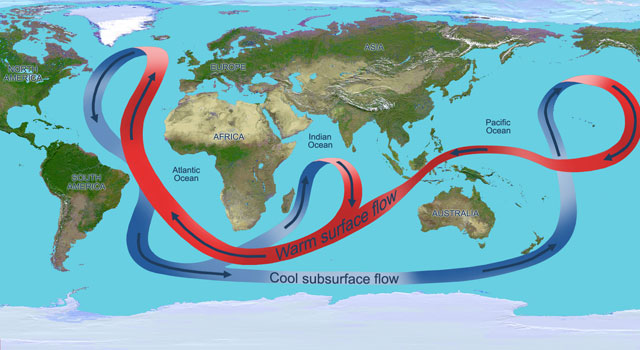May 9 - June 2, 2025
Ocean currents move warm and cold water all around Earth, and these water motions help maintain Earth’s climate. About 30 years ago, a famous oceanographer named Dr. Wallace Broecker put lots of data about ocean currents together and proposed that there is a very large pattern of currents flowing through all the ocean basins: the Atlantic, Pacific, Indian and Southern Ocean (the Southern Ocean is the name given to the large ocean region that encircles Antarctica). He described this pattern like a giant conveyor belt, with warm surface currents flowing toward the North Pole in the Atlantic Ocean, , where they cool and sink and turn into cold deep currents flowing away from the North Pole toward the other ocean basins.

The great ocean conveyor. Adapted from Broecker, 1991. credit: NASA/JPL
This conveyor-like pattern is very important to life in the oceans and on land, making some regions warm and others cold, some regions very wet and other regions very dry. This affects where certain animals can live, and where humans can grow food. The sinking of water from shallow to deep ocean is also pulling extra carbon dioxide from burning gas an oil out of the atmosphere and into the deep ocean, temporarily protecting life on Earth from the worst impacts of the Greenhouse Effect. So many physical oceanographers study this global pattern of ocean currents to help us understand what makes it move, and what changes might cause the conveyor to speed up or slow down.
Dr. Amy Bower is leading a group of physical oceanographers researching one important location in the Atlantic Ocean where the warm shallow current flowing northward is interacting with the cold deep current flowing in the opposite direction. The shallow current is sometimes right on top of the deep current, and we aren’t sure what happens. Does the deep current stop? Does the deep current go off in a different direction?
Those are the kinds of questions we hope to answer in the Crossroads research project. We call it “Crossroads” because these two giant currents, the North Atlantic Current and the Deep Western Boundary Current, are crossing over each other.
To figure out what happens, we will be releasing about 80 buoys from a ship that will sink down to the depth of the Deep Western Boundary Current and drift with that current for two years. The floats will be tracked underwater using sound signals from six sound beacons that we will set up in the region before we release the floats. We won’t know where the floats are during their two-year drift—only after two years, when the floats automatically pop up to the surface and transmit their data to satellites will we be able to reconstruct their underwater travels. This is the only way that we can “see” where the deep currents go. Over the two years that the floats are drifting with the Deep Western Boundary Current, we can keep track of what the shallower North Atlantic Current is doing because we can observe its location from satellites that can track shallow currents. After two years, we will put all the information together about the deep and shallow currents and learn something new about how these two important currents interact in this crossroads of the North Atlantic Ocean.